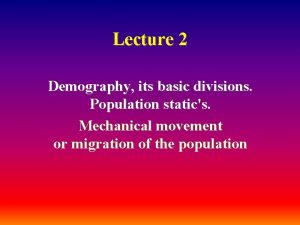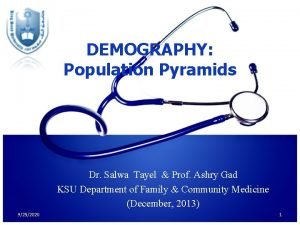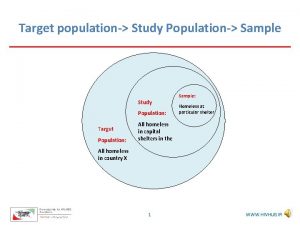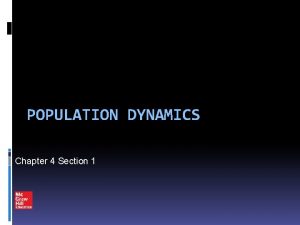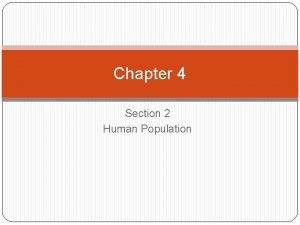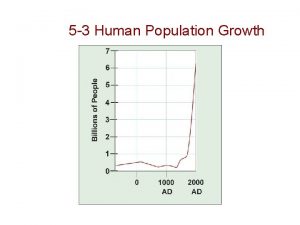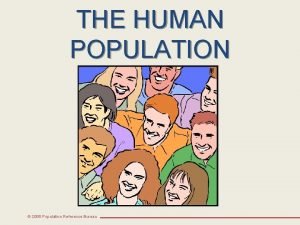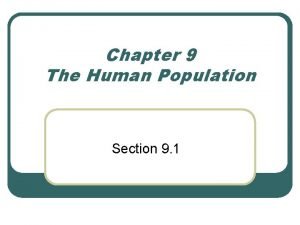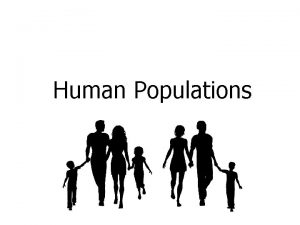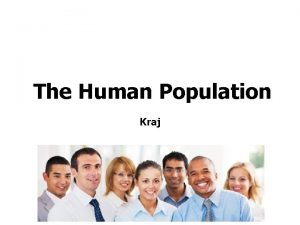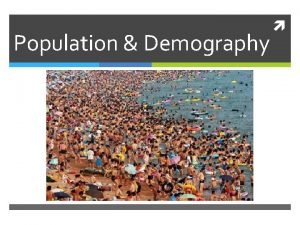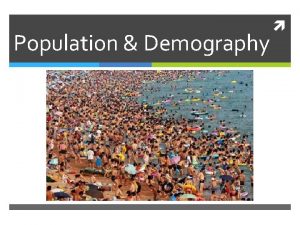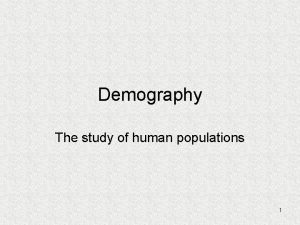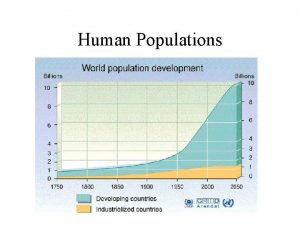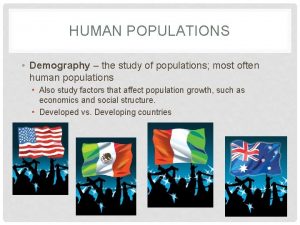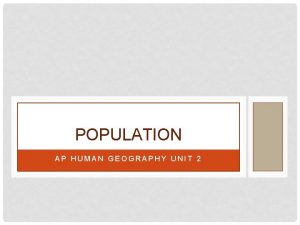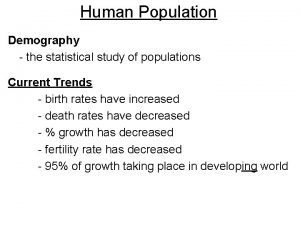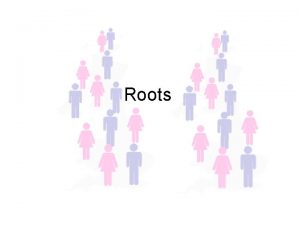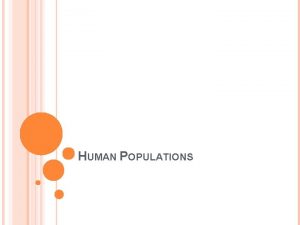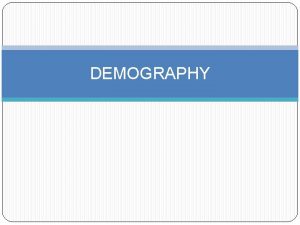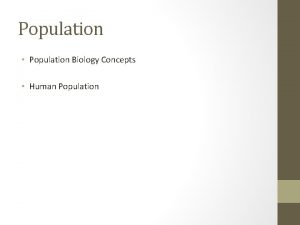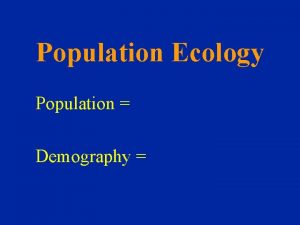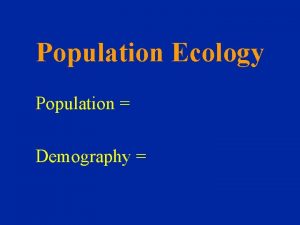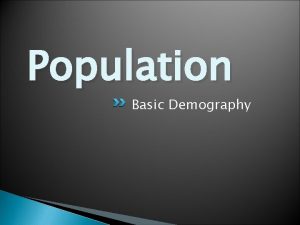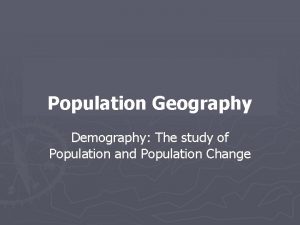Demography the study of human populations and population








































- Slides: 40

Demography- the study of human populations and population trends. Chapter 7 The Human Population

The Environmental Implications of China’s Growing Population One Child Policy

The Environmental Implications of China’s Growing Population Miniature earth video

World in the Balance The People Paradox Video

World Population Carrying Capacity video

World population count Every 5 days, the human population increases by roughly 1 million lives! Until a few hundred years ago the population was stable. Why did it change?

Scientists Disagree on Earth’s Carrying Capacity • Thomas Malthus (1798) thought the human population could exceed Earth’s carrying capacity. • How can we increase food supply suddenly? Can we expand our carrying capacity? Theoretical models of food supply and population size.

Factors that Drive Human Population Growth • • • Net Migration Changes in Population Size Fertility Life Expectancy Age Structure

Changes in Population Size 1. Net migration rate- the difference between immigration and emigration in a give year per 1, 000 people in the country. • Input – output total pop X 1, 000

• • • Net Migration Rate Country X has 50, 000 people. In a particular year, the country received 250, 000 immigrants (in-migrants) and lost 55, 000 emigrants (outmigrants). What is the net migration rate? Country Y has 45, 000 people. In a particular year, the country received 35, 000 immigrants and lost 45, 000 emigrants. What is the net migration rate? Country Z has 37, 000 people. In a particular year, the country received 1, 000 immigrants and lost 1, 000 emigrants. What is the net migration rate?

Changes in Population Size 2. Birth and Death rates • Crude Birth Rate (CBR) – the number of births per 1, 000 individuals per year. • Crude death rates (CDR) – the number of deaths per 1, 000 individuals per year. • Global population growth rate = [CBR-CDR] X 100 or [CBR-CDR] 1000 10 **We do not factor migration for global population because people are not leaving the Earth.

• • • Global Population Growth Rate Country X has 20 births and 8 deaths per 1, 000 people. What is the growth rate solely based on CBR and CDR? Country Y has 300 births and 150 deaths per 1, 000 people. What is the growth rate solely based on CBR and CDR? Country Z has 37, 000 people. Per 1, 000 people, 12 are born and 14 die. What is the annual growth rate based on CBR and CDR alone?

Changes in Population Size • Nation Population growth rate % = [(CBR + Immigration) – (CDR + Emigration)] X 100 original population • We can say that a population will double in a certain number of years if the growth rate remains constant. The Rule of 70 is an approximation of how long it will take for a population to double its size (or halve its size) given the current growth rate Doubling time = (in years) • Rule of 70 video 70. Growth rate%

Changes in Population Size • • Find the national population growth rate of country X, Y, and Z given information on previous slides Find the doubling time of countries X, Y, and Z given the national growth rate you previously determine.

Changes in Population Size

• 3. Fertility Total fertility rate (TFR)- an estimate of the average number of children that each woman in a population will bear. • • • Replacement level fertility- the total fertility rate required to offset the average number of deaths in a population and for the current population size to remain stable. Developed countries - typically stable, RLF = 2. 1 • • Why? Developing countries – RLF = greater than 2. 1 • • • It is a measure of births per woman. Why? When will a country experience a decease in population? When will a country experience an increase in population?

4. Life Expectancy • • • Life expectancy - the average number of years that an infant born in a particular year in a particular country can be expected to live, given the current average life span and death rate of that country. A high life expectancy equals: Reported in three ways:

♂ 75 ♀ 81 4. Life Expectancy 2008 data 2011 data: Overall – 79 years ♂ 76. 3 ♀ 81. 1 ♂ 67 ♀ 70

• • 4. Life Expectancy Infant mortality rate - the number of deaths of children under 1 year of age per 1, 000 live births. Child mortality rate - the number of deaths of children under age 5 per 1, 000 live births. • If a country has a high life expectancy and a low infant mortality rate what can you predict? • Low life expectancy and a high infant mortality rate what can you predict?

Aging and Disease • • • Elderly population versus younger population Disease is a regulator of human populations. Heart Disease is #1. Infectious diseases are #2 AIDS How are the # of AIDS related deaths improving? The reality of Zimbabwe video

5. Age Structure • • • Age structure diagrams (population pyramids)- visual representations of age structure within a country for males and females. Describes how its members are distributed across age ranges, usually in 5 -year increments. Predict speed of population increase and future size.

5. Age Structure • Countries can be grouped into 3 broad categories: 1. Pyramid = widest at the bottom, smallest at the top. • • • More younger people than old. Typical of a developing country. A rapidly growing population. Population momentum – demonstrates that it takes time for actions that attempt to reduce births to catch up with a growing population.

5. Age Structure • Countries can be grouped into 3 broad categories: 1. Column = Little difference between # of individuals in young age groups verse old age groups. • • • Have slow population growth or no growth at all. Typical of developed countries. Developing countries that have recently lowered their growth rates should begin to see this pattern within the next 10 -20 years.

• 5. Age Structure Countries can be grouped into 3 broad categories: 1. Inverted Pyramid = More older people than younger people. • • TFR below 2. 1 Decreasing # of females within each younger age group. Typical of developed countries and population will continue to shrink over time. China is in the early stages of showing this inverted pyramid.

• • The Demographic Transition video The theory of the demographic transition is theory that as a country moves from a subsistence economy to industrialization and increased affluence, it undergoes a predictable shift in population growth. There are 4 phases: 1. Pre-industrial 2. Industrialization 3. Stabilization - Birth rates slow down 4. Population stops growing.

The Stages of the Demographic Transition • • • Phase 1: Slow population growth because there are high birth rates and high death rates which offset each other. Pre-industrialization Life expectancy? Infant mortality rate? Why are children considered an asset?

• • The Stages of the Demographic Transition Phase 2: Rapid population growth because birth rates remain high but death rates decline due to better sanitation, clean drinking water, increased access to food and goods, and access to health care. State of imbalance Developing countries Industrialization Life expectancy? Infant mortality rate? TFR? Include countries such as:

• • The Stages of the Demographic Transition Phase 3: Stable population growth as the economy and educational system improves and as family income increases people have fewer children. Birth rates begin to decrease. Death rates decrease. Stabilization How are children viewed? Many developed countries. Include countries such as:

Wealthier nations tend to have lower total fertility rates

• • The Stages of the Demographic Transition Phase 4: Declining population growth because the relatively high level of affluence and economic development encourage women to delay having children. Birth rates well below death rates. More old, fewer young. Population usually stops growing. Problematic? Solution? Countries such as:

• • Family Planning Women – more education and working = delaying/having less children. Treated as equals with their partner. More access to birth control. Practice Family planning- the regulation of the number or spacing of offspring through the use of birth control.

• Family Planning posters Kenya and Thailand are two “success” stories • • Kenya: 1980 s—TFR was 8; 1990 s—TFR was 4 Thailand: dropped growth rate from within the first 15 years from 3. 2% to 1. 6% - 0. 6% today Thailand video

The 12 Most Populous Countries in the World

• Ecological Footprints Affluence - having a lot of wealth such as money, goods, or property. U. S. has more than 5 times the environmental impact of a person living in China and 18 times that of a person living in Haiti.

• • The IPAT Equation A conceptual representation used to estimate the impact of human lifestyles on Earth we can use the IPAT equation: Impact = Population X Affluence X Technology • • Impact – Overall environmental effect Population – more people, larger impact on the environment. Affluence – the more affluent a person or society, the higher the environmental impact Technology - can either degrade or create solutions to minimize our impact.

3 Impacts on the environment 1. Local – more impact from developing nations because produce locally. • Benefit? • Con? • 2 common overused resources: • Land/agriculture • Impacts: • Woody biomass

3 Impacts on the environment 2. Global – more impact from developed nations. • Consumption of imported goods • Faster resource depletion because of affluence

3 Impacts on the environment 3. Urban • An urban area is an area that contains more than 386 people per square kilometer or 1000 people per square mile. • 75% of people in developed and 44% of people in developing nations.


Gender Equity and Population Control in Kerala
 Population demography definition
Population demography definition Exclave ap human geography definition
Exclave ap human geography definition Static demography
Static demography Cso business demography
Cso business demography Elements of demography
Elements of demography Difference between a sample and a population
Difference between a sample and a population Components of demography
Components of demography Slash and burn agriculture antonym
Slash and burn agriculture antonym Population ecology section 1 population dynamics answer key
Population ecology section 1 population dynamics answer key Population ecology section 1 population dynamics answer key
Population ecology section 1 population dynamics answer key Population ecology section 1 population dynamics
Population ecology section 1 population dynamics Study guide section 1 population dynamics
Study guide section 1 population dynamics Stabilizing selection human birth weight
Stabilizing selection human birth weight Evolution of populations section 16-1 genes and variation
Evolution of populations section 16-1 genes and variation Why do mexico and peru have primarily catholic populations
Why do mexico and peru have primarily catholic populations Chapter 21 vulnerability and vulnerable populations
Chapter 21 vulnerability and vulnerable populations What is a study population
What is a study population Study population
Study population Chapter 4 section 1 population dynamics
Chapter 4 section 1 population dynamics Chapter 4 section 2 human population answer key
Chapter 4 section 2 human population answer key Chapter 4 section 2 human population answer key
Chapter 4 section 2 human population answer key Section 5-3 human population growth
Section 5-3 human population growth Slow growth age structure diagram
Slow growth age structure diagram Human population
Human population What is a manifestor human design
What is a manifestor human design Baby boom definition ap human geography
Baby boom definition ap human geography Av
Av Chapter 9 the human population section 1
Chapter 9 the human population section 1 Hình ảnh bộ gõ cơ thể búng tay
Hình ảnh bộ gõ cơ thể búng tay Ng-html
Ng-html Bổ thể
Bổ thể Tỉ lệ cơ thể trẻ em
Tỉ lệ cơ thể trẻ em Chó sói
Chó sói Tư thế worms-breton
Tư thế worms-breton Chúa yêu trần thế
Chúa yêu trần thế Môn thể thao bắt đầu bằng chữ f
Môn thể thao bắt đầu bằng chữ f Thế nào là hệ số cao nhất
Thế nào là hệ số cao nhất Các châu lục và đại dương trên thế giới
Các châu lục và đại dương trên thế giới Công thức tính thế năng
Công thức tính thế năng Trời xanh đây là của chúng ta thể thơ
Trời xanh đây là của chúng ta thể thơ Mật thư tọa độ 5x5
Mật thư tọa độ 5x5


